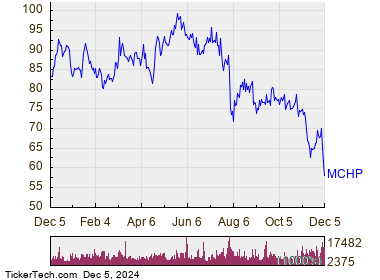Understanding the Relative Strength Index (RSI) and Its Implications for Investors
In the world of stock trading, sentiment can often dictate market movements. Legendary investor Warren Buffett offers a guiding principle: be cautious when the market is optimistic and be bold when there’s fear in the air. One effective method to gauge this "fear" is through a technical indicator known as the Relative Strength Index (RSI).
What is the Relative Strength Index (RSI)?
The Relative Strength Index is a technical analysis tool that quantifies momentum in the stock market, generating readings on a scale from 0 to 100. The RSI serves as a momentum oscillator, indicating whether a stock may be overbought or oversold. A stock is often considered oversold when its RSI dips below 30, suggesting that the price may have fallen too quickly, leading to a potential buying opportunity.
Microchip Technology: A Case Study
Consider the stock of Microchip Technology Inc., trading under the symbol MCHP. Recently, the stock has experienced heightened selling pressure, resulting in an RSI reading of 29.9, indicating it’s entering the oversold territory. During a recent trading session, MCHP shares dipped to a low of $58.17 each.
In contrast, the S&P 500 ETF, represented by SPY, currently holds an RSI of 66.7. This differentiation suggests that while the broader market may be trending positively, Microchip Technology has seen notable selling activity.
Analyzing Microchip’s Stock Range
Within the past year, MCHP has encountered significant fluctuations in stock price. Its 52-week low stands at approximately $58.08, while the peak during the same period hit $100.565. This dramatic range indicates volatility and offers a valuable perspective for potential investors. A recent closing price of $58.09 reflects that the stock is hovering near its yearly low.
By examining this data, a bullish investor might interpret the RSI reading as a signal that selling pressure could be waning, opening avenues for strategic entry points to purchase shares.
Exploring Additional Oversold Stocks
Investors looking for other undervalued opportunities might find interest in a range of oversold stocks. Identifying similar scenarios can uncover potential investments that may benefit from price corrections as market conditions shift.
How to Use RSI in Trading Strategies
When leveraging the RSI for trading decisions, investors should integrate it with additional indicators and analyses. While an oversold RSI can signal a potential price rebound, it’s essential to consider a holistic view of market trends, company fundamentals, and external economic factors.
RSI Signals and Trading Plans
Buying Opportunities: An RSI below 30 may indicate a potential buying opportunity. Traders should watch for additional signals, such as bullish reversals or support levels.
Selling Opportunities: Conversely, an RSI above 70 often indicates overbought conditions. Traders should contemplate selling or taking profits if additional analysis supports this decision.
- Divergence: When the price makes new highs or lows that deviate from the RSI, it can signify potential reversals. This divergence can provide critical insights when making trades.
The Importance of Combining Indicators
Reliance solely on the RSI can lead to false signals. It’s crucial to pair it with other tools such as moving averages, volume analysis, and additional momentum indicators. This multi-faceted approach enhances the probability of successful predictions in stock movements.
Moving Averages and RSI
Moving averages offer a different perspective on stock performance. When combined with the RSI, they can clarify trends and help confirm buy or sell signals. For example, if a stock’s RSI indicates it is oversold, but the moving average trend is consistent, it may bolster the case for purchasing.
Monitoring Market Sentiment and Economic Conditions
Investors should also stay updated on broader economic indicators and market sentiment. Factors such as interest rates, inflation, and geopolitical events can influence stock prices significantly.
Keeping an Eye on Economic Indicators
- Interest Rates: Rising interest rates can dampen market enthusiasm and lead to increased selling pressure.
- Inflation Metrics: High inflation could impact corporate profits and spending patterns, leading to volatility in stock prices.
- Market Sentiment: Tracking investor sentiment can provide insights into potential stock movements, whether through fear or greed.
Understanding Stock Volatility
Understanding stock volatility is critical for any investor. Market conditions can change rapidly, and stocks may experience sharp movements in short time frames. Tools like the RSI can help navigate this landscape.
Factors Contributing to Volatility
- Earnings Reports: Companies releasing earnings that miss or exceed expectations can lead to immediate stock reactions, impacting the RSI.
- Sector Trends: Technology, healthcare, or consumer goods sectors may experience different levels of volatility based on news, trends, or innovations.
- Market Events: External events such as regulations, global crises, or significant market changes can drastically shift stock valuations.
Conclusion
The Relative Strength Index is a valuable tool for investors seeking to navigate the complexities of stock trading. By understanding how to interpret RSI readings—as well as integrating them with other market indicators and trends—traders can improve their strategies. Investing in stocks like Microchip Technology demonstrates how applying these concepts can guide decision-making in both bullish and bearish environments. As always, thorough research and analysis are vital for successful trading outcomes.
